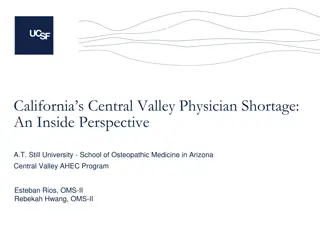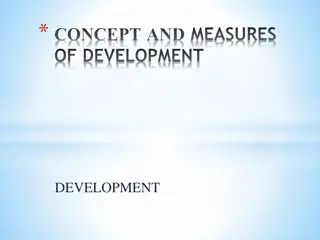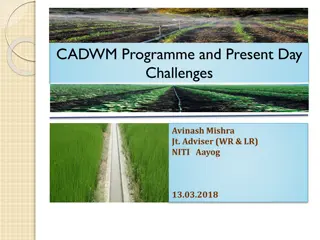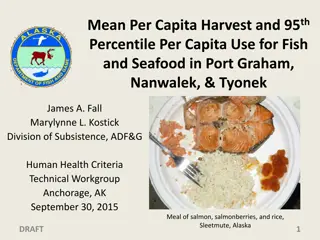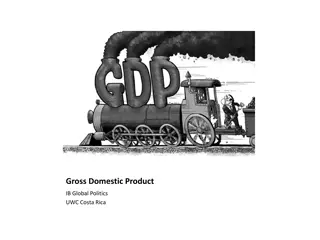Preparing the food data collected in HIES for analysis
The steps and considerations involved in processing in-house food quantities and meals consumed data collected in HIES for the analysis, focusing on the distribution of household average dietary energy consumption per capita. It highlights the importance of this distribution in estimating poverty an
8 views • 35 slides
DEPARTMENT OF HEALTH AND SOCIAL SERVICES
An overview of the benchmark trend in health care spending in Delaware for the year 2021. It includes data collected from various sources and highlights changes in total health care expenditures, COVID-19 relief payments, per capita spending, quality benchmarks, and more.
5 views • 14 slides
Energy Sector Status and Potential Resources in South Sudan
The Republic of South Sudan has the lowest energy access rate in Sub Sahara Africa, with per capita consumption of 3kWh. The demand for electricity is expected to grow annually, pushing for more sustainable and cost-effective energy solutions. The country's current installed capacities include diese
1 views • 27 slides
Understanding Concepts of National Income in Economics
Explore the concepts of national income presented by Dr. Rashmi Pandey, covering key indicators such as Gross National Product (GNP), Gross Domestic Product (GDP), Net National Product (NNP), Net Domestic Product (NDP), Personal Income, Disposable Income, Per Capita Income, and Real Income. Gain ins
0 views • 22 slides
Understanding National Income and Its Importance in Economics
National income is a crucial measure of the value of goods and services produced in an economy. It provides insights into economic growth, living standards, income distribution, and more. Concepts such as GDP, GNP, Personal Income, and Per Capita Income help in understanding the economic health of a
5 views • 14 slides
Medicare Advantage Plan Payment Rate Trends Over the Past Decade
Analyzing the annual percentage changes in national per capita Medicare Advantage growth rates over the past decade reveals fluctuations in payment rates, with an average annual growth rate of 2.87%. The data reflects the evolving landscape of Medicare Advantage plan payments and policy updates. Thr
0 views • 5 slides
Low Pay Household Estimates in Rural India
Analysis of data from the Periodic Labour Force Survey reveals estimates of households with monthly per capita earnings below a threshold in Rural India. The study, presented by Vasavi Bhatt, focuses on the characteristics of low earnings households and highlights the importance of decent work and i
1 views • 8 slides
Addressing Physicians Shortage in California's Central Valley
The San Joaquin Valley in California faces a severe physician shortage, with the lowest doctor-per-capita ratio in the state. To tackle this issue, efforts are being made to establish the Central Valley Medical Association, organize the first Central Valley Medical Conference, and gather insights fr
2 views • 13 slides
Contrasting Characteristics of Developed and Developing Countries
Developed countries are characterized by high per capita income, strong GDP growth, and advanced standards of living, while developing countries exhibit lower income levels, high population growth, and challenges in technology and infrastructure. The differences extend to economic, demographic, tech
1 views • 7 slides
Oklahoma School Safety Protocols Overview
Overview of the school safety protocols in Oklahoma, which define requirements based on COVID-19 alert levels per capita in each county. The protocols include instructions for different alert levels, mask recommendations, visitor limitations, and activity guidelines. Schools are expected to offer in
0 views • 9 slides
Understanding Economic Development: Concepts and Measures
Economic development goes beyond just economic growth and encompasses social and monetary progress. It involves factors like job creation, technological advancements, standard of living, per capita income, and more. Measurements include GNP, GNP per capita, welfare, and social indicators. Developmen
0 views • 8 slides
Understanding Global Economic Disparities and Growth Trends
Explore the significant differences in living standards and economic growth rates across countries, from advanced economies like the UK to middle-income nations like Mexico and low-income countries like Mali. Real GDP per capita, life expectancy, literacy rates, and growth data provide insights into
0 views • 27 slides
Urbanization, Unemployment, and Migration: Impact on Socio-Economic Development
Urbanization, a key factor in socio-economic change, is linked to per capita income growth. The association between urbanization and development is evident worldwide, with rapid urban growth in developing countries. In Africa, high rural-urban migration and urban fertility rates drive urbanization.
3 views • 31 slides
Overview of Modern Business Environment in Indian Economy
Modern business in the Indian economy is characterized by large size, oligopolistic nature, diversification, global presence, technology orientation, and changing government regulations. The Indian economy features a mixed economy with both private and public enterprises, low per capita income, uneq
0 views • 14 slides
Overview of Business Environment and Economy in India
Business environment in India encompasses a mix of large, oligopolistic, diversified, and technologically oriented enterprises. The Indian economy is characterized by a mixed economy, low per capita income, and limited entrepreneurial potential. External and internal factors influence business opera
0 views • 14 slides
Analysis of Indian Economic Growth: Perspectives and Turnaround
Dr. Shailesh Kumar, Assistant Professor at Bharati College, University of Delhi, delves into the Indian growth experience from two perspectives - aggregate growth over time and variations across states. The turnaround in growth measures post-1980, including GDP per capita and productivity, has been
1 views • 12 slides
Challenges in Managing Water Resources in India
Water scarcity and inefficient water use pose significant challenges in India, with decreasing per capita water availability and a lack of proper infrastructure leading to gaps in irrigation potential utilization. Factors such as poor storage capacity, uneven water distribution, and low water use ef
5 views • 16 slides
Understanding GDP and Economic Indicators
Evaluating the economy involves analyzing total income per person, comparing revenue and spending, and examining GDP per capita. GDP, a key economic indicator, reflects the total market value of goods and services produced in a country. Rich data sources like World Bank provide insights into various
0 views • 27 slides
Insight into Economic Misery and Presidential Elections
Exploring the relationship between economic indicators like unemployment rate, inflation rate, and real GDP, and their impact on presidential elections. Discusses the Misery Index, real GDP per capita growth rule, and effective economic rules that influence election outcomes.
5 views • 4 slides
International Economic Indicators Comparison
The data presented includes GDP per capita rankings for various countries in 2015, showcasing the economic status of nations like Qatar, Norway, and the United States. It also illustrates the growth in GDP per capita from 2006 to 2015, with countries like China and India showing significant progress
2 views • 21 slides
Understanding Regional Disparities: Causes and Impacts in India
Regional disparities in India are evident through differences in income, education, health services, and industrialization levels among regions. Historical, geographical, economic, and governance factors contribute to these disparities, impacting overall economic growth. Measures such as analyzing p
0 views • 12 slides
Exploring Global Development Disparities through Key Indicators
Revealing significant contrasts in welfare metrics across countries, such as per capita income, children out of school, infant mortality rates, life expectancy, and poverty levels. The data highlights the complexities of development challenges and the varied approaches taken towards welfare reforms
0 views • 15 slides
CSU Travel Policy: Per Diem Implementation Guidelines
In this detailed guide, learn about the implementation of per diem in CSU Travel Policy, reasons for moving from actuals to per diem, coverage areas, GSA rates, and the benefits of per diem over receipts. Get insights into complying with federal guidelines, avoiding tax implications, and the per die
0 views • 23 slides
Overview of Development Economics and Goals
Development economics is a branch of economics that focuses on improving the economies of developing countries by targeting factors such as health, education, working conditions, and policies. It involves macroeconomic and microeconomic analysis to enhance domestic and international growth. Differen
1 views • 11 slides
Overview of Economic Development Theories and Determinants
Economic development is a vital area of study that focuses on the causes and solutions for poverty in nations. This field examines the process of increasing per capita income and economic welfare in a country over time. Key viewpoints on economic development, including classical and modern perspecti
1 views • 8 slides
Insights on Ukraine Payroll Tax Reforms and Wealth Disparities: Lessons from Bulgaria
Explore the dynamics of Ukraine's payroll tax reforms and wealth indicators in comparison with Bulgaria, examining historical contexts, welfare situations, and macroeconomic factors such as GDP per capita, debt levels, and employment rates. Insights into cost of living differentials, tax structures,
0 views • 24 slides
Dairy Market Insights in Kazakhstan: Consumption Trends and Dynamics
In 2021, milk and dairy consumption in Kazakhstan saw a decrease in per capita consumption, with varying rates in urban and rural areas. The highest consumption was in Eastern Kazakhstan region, while Shymkent had the lowest. The dairy market dynamics in March 2022 showed a slight decrease in volume
1 views • 9 slides
Population Management and Sustainable Harvesting Strategies
Actual population numbers exhibit complex fluctuations influenced by predation and other factors. Understanding concepts like Maximum Sustainable Yield (MSY) and Minimum Viable Population (MVP) can help in managing populations effectively. The concept of MSY ensures the maximum harvest of a renewabl
0 views • 32 slides
Financial Strategies for Small Towns: Case Study of Town of Hillsville, Virginia
Davenport & Company LLC conducted a Comprehensive Financial Review for the Town of Hillsville focusing on its General Fund and Utility Enterprise Fund. The review includes historical financial data, peer comparisons, debt analysis, and recommendations for financial policies and investments. Peer com
0 views • 20 slides
Comparison of Healthcare Provisions in Senate and House AHCA Bills
The Senate AHCA bill proposes major changes to healthcare provisions compared to the current ACA, such as removing the individual mandate and employer mandate. Tax credits would be based primarily on age rather than income, and cost-sharing subsidies may end in 2020. Insurers could charge older cust
0 views • 5 slides
Malaysia's Comprehensive Development Planning Strategies
Malaysia's experience in compiling statistics for development planning is highlighted through the high-level seminar and workshop on the ACSS Strategic Plan 2016-2020. The country's development plans include the 11th Malaysia Plan, Government Transformation Programmes, New Economic Model, and Econom
0 views • 11 slides
Evolution of Public Policies and Income Patterns: Insights from India
Comprehensive analysis of changing intergenerational support for elderly in India from 2004-05 to 2011-12, alongside initiatives like the Unorganized Sector Workers Social Security Act, the National Rural Employment Guarantee Act, and the National Rural Health Mission. The shift in per capita income
0 views • 15 slides
Insights into Retirement Plans in the Regulated Sector
Explore the dynamics of Defined Benefit (DB) and Defined Contribution (DC) retirement plans in the regulated sector, focusing on trends, key considerations, per capita costs, and the complexities of managing DB costs. Learn about the shift from DB to DC plans, derisking strategies, and the impact on
0 views • 20 slides
Global Perspectives on Poverty and Inequality
Explore dimensions of poverty and inequality worldwide through images and data on living conditions, GDP per capita, household income, and life expectancy in various countries. Learn about income distribution, family living conditions, and the Dollar Street project revealing disparities in lifestyle
0 views • 163 slides
Squaxin Island Tribe General Welfare Program Overview
Overview of the Squaxin Island Tribe's General Welfare Program, including information on per capita benefits, enrollment process, qualifying expenses, key exceptions, documentation, payment methods, and examples of qualifying expenses for reimbursement.
0 views • 19 slides
Trends in National Health Expenditures and Care Costs, 1960-2010
National health expenditures per capita and as a share of GDP from 1960 to 2010, along with average annual growth rates, show the evolving landscape of healthcare spending in the U.S. The data reveals changing patterns in healthcare expenditure and outlines the concentration of health care spending
0 views • 20 slides
Mean Per Capita Harvest and 95th Percentile Per Capita Use for Fish and Seafood in Alaska
This document provides information on the mean per capita harvest and 95th percentile per capita use for fish and seafood in Port Graham, Nanwalek, Tyonek, and Sleetmute, Alaska. The data is from a technical workgroup report dated September 30, 2015, and includes details on a meal of salmon, salmonb
1 views • 10 slides
Understanding GDP and its Limitations in Global Economics
The Gross Domestic Product (GDP) measures the monetary value of goods and services produced within a country, reflecting its economic development. However, simply comparing GDP figures may not provide a complete picture. GDP per capita is a better indicator, showing the average wealth per person. De
0 views • 7 slides
Insights on the Canadian Charity Sector 2010-2018: A Blumberg Snapshot Analysis
Analysis of the Canadian charity sector from 2010 to 2018 based on Blumberg's Snapshot. The report covers data on the number of charities filing T3010s, charities with websites, charities per capita in Canada, charity assets and liabilities, and inflation trends during the period. Key findings inclu
0 views • 16 slides
Global Relationship Between GDP per Capita and Mineral Resource Consumption Rates in 2000
The images depict the relationship between GDP per capita and domestic consumption rates of industrial minerals, ore, and construction materials in various countries in the year 2000. The data highlights the varying consumption patterns and their correlation with economic prosperity. Additionally, s
1 views • 10 slides







